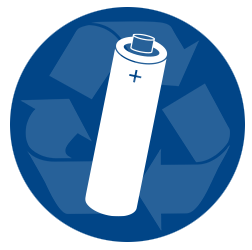 Please read the following filling instructions carefully and attentively, especially the "Consequences of improper filling
Please read the following filling instructions carefully and attentively, especially the "Consequences of improper filling
of containers", as compliance with the instructions is mandatory from the point of view of waste and dangerous goods legislation.
For handling the various battery groups, especially lithium batteries, there is the collection of dangerous goods regulations
of the ADR with special regulations and instructions, the summary of which is quite comprehensive.
For lithium cells and batteries, ADR special regulations 636, 377 and 376 in conjunction with packaging regulations
packing instructions P 909 and P 908 must be observed.
If a delivery contains less than 333 kg of Li batteries, they may be transported without dangerous goods labelling in accordance with SV 636.
If the quantity is exceeded, SV 377 applies and it is a transport of dangerous goods.
Please only return portable batteries, no industrial batteries (e.g. e-bike) and starter batteries!
Important requirement for the return:
- only dry batteries
- Li batteries / cells must not have any externally visible damage or degassing
- transport cartons must not be torn open, creased or damaged in any other way
- cartons must be closed, the lid must not be torn off
- no packaged batteries
- all packaging materials must be removed in advance
Return possible: Cartons with commercially available battery mixtures, including Li batteries only < 500 g, Li content max. 4%.
Damaged cartons must not be used!
According to packaging instructions P 909 / P 908, the cells and batteries must be packaged in such a way that:
- protection against short circuits and dangerous heat generation is guaranteed and
- excessive movement during transport is prevented.
In the case of Li mixtures, all Li batteries must be secured in accordance with ADR.
Please tape off the terminals, pack the batteries if necessary and fill the empty space with sand.
Make sure to use dry vermiculite or dry sand as filling material if possible.
What are the consequences of improper filling of the containers?
All costs incurred as a result of incorrect filling shall be borne by the filler.
Solutions for small lead-acid batteries
Only portable batteries, no starter batteries.
The small lead-acid batteries are collected as a mono fraction, preferably in standard collection boxes and secured on a Euro pallet.
The terminals must be protected against short circuits and damage (tape the terminals or temporarily store them in cardboard).
Solutions for button cells
If there is an increased proportion of button cells in the battery mixture or if the batteries are filled with button cells only, the poles of the button cells must be taped off and the batteries placed in dry sand for safety reasons. The terminals must be masked with transparent adhesive tape so that the labelling of the chemical composition of the button cells is still legible.
PS: This summary is merely an extract of important regulations and instructions.
It does not claim to be exhaustive, but is intended to draw the user's attention to the possible hazards
handling lithium cells and batteries and how to avoid them.
 Active Components
Active Components
 Automation Technology
Automation Technology
 Batteries
Batteries
 Cables and Adaptors
Cables and Adaptors
 Chemical Auxiliaries
Chemical Auxiliaries
 Connectors
Connectors
 Electric Mobility
Electric Mobility
 Electronic Cooling
Electronic Cooling
 Enclosures
Enclosures
 Fuses
Fuses
 Measuring Technology
Measuring Technology
 Mechanical Components
Mechanical Components
 Mounting Accessories
Mounting Accessories
 Network and Computers
Network and Computers
 Optoelectronics
Optoelectronics
 Passive Components
Passive Components
 Power Supply
Power Supply
 Protective Cases
Protective Cases
 Raw Cables
Raw Cables
 Sensor Technology
Sensor Technology
 Soldering Technology
Soldering Technology
 Tools
Tools




